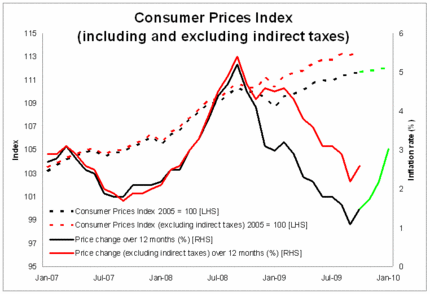Are expectations of inflation too low?
Inflation is now on the way up. That was to be expected. As Mervyn King, Governor of the Bank of England, keeps reminding us, we should expect inflation to be very volatile for some while.
But, is it me or do the forecasts for inflation reaching a mini-peak at about 3% in the early part of next year seem to be a little timid?
The reason I am a bit unsettled is that if expectations for inflation prove to be significantly on the lower side, this may lead to an upward pressure on mortgage rates and lending rates in general.

Looking at the Bank of England fan charts, the assumption seems to be that inflation will peak at about 3% (see page 40 of the November 2009 Inflation Report). And there is a mood among economists that the rate may just top the 3%, which would force a letter from Mr King to the Chancellor.
Should the letter be written, the Governor of the Bank of England will tell Alastair Darling not to worry because inflation is a bit volatile at the moment and should receded in the coming months. And almost certainly he will be right about inflation receding.
My unease, however, is with the level the next peak will reach. I can’t help but think that there is more than an outside chance that inflation will top the upper expectations of the Bank’s forecast fan chart.
For those with an interest in these things the fan charts the Bank uses cover outcomes likely 90 out of 100 times. So the Bank thinks that there is less than a 1 in 10 chance (given that there is a chance of undershoot and overshoot) that the inflation will actually rise above the level depicted in the fan chart.
The reason I feel uneasy is that I am not fully convinced by the assumptions being made about the effect of the reintroduction of the 17.5% rate of VAT.
Comparing the level of consumer price inflation excluding indirect taxes with the standard CPI index it seems plain that we should expect the planned rise in VAT in the New Year to create fairly sharp upward pressure on an inflation rate that is already on the rise.
If we look at the graph (sourced from ONS data) we see the reduction in the VAT rate had quite a reasonable impact on inflation. The gap between the two indexes increased by about 1.3%, suggesting a drop in price of about that proportion was a result of tax changes.
Now this does not mean that a reversal of the rate will mean an increase of this magnitude. As the Bank wisely suggests some retailers may be pricing in the reintroduction ahead of time as they manage the ticketed price points of their goods. This will act to mute the effect.
But these two indexes will have to come into closer alignment, unless there is further significant tinkering with the indirect taxes. Part of this will most likely be the created by downward pressure on the CPI (ex indirect tax) measure, but a large part of the adjustment will result from a rise in the headline CPI measure. The question is: how much?
It does seem reasonable to assume (that is code for I haven’t checked) that the levels of inventories retailers will carry this year heading into Christmas will be weighted on the light side, which should reduce the need for savage discounts in the January sales. If this is the case the seasonal fall in prices at the start of the year may well be much less it was last year, thereby creating further upward pressure on the headline inflation rate.
Producer prices too offer more scope for concern, as inflation here is on the rise.
Now I fully accept that there are huge numbers of variables here and a high level of uncertainty.
But if we look at projecting the CPI measure of inflation forward to hit 3% in January (see the green line), we see that the increase in prices from where they stand today is very limited if the Banks’ expectations are to be met. This probably means that prices will need to fall if the effects of VAT are to be accommodated.
Now I accept the good people at the Bank possess exceptional brainpower and can put some pretty fancy modelling into action and they will have taken into account far more than I have sought to here. So it would be folly for me to suggest that they are badly mistaken.
But I can’t help but sense that the inflationary pressures may be a little stronger than the consensus among experts would have us believe. And in this regard I can only point to the assessment of future inflation in the August Inflation report, which suggested a mini-peak early next year of less than 2.5%.
I hope my worries prove unfounded.